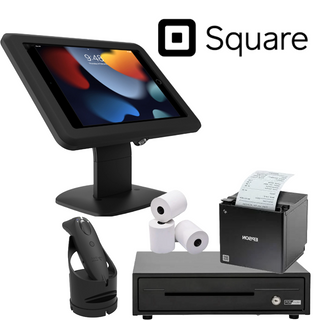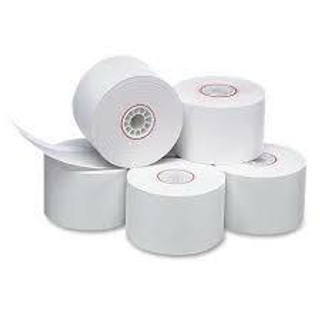Direct Thermal Labels: Everything You Need to Know.
Posmartt, your one-stop shop for all things labeling, brings you this comprehensive guide to Direct thermal labels. We'll delve into everything you need to know, from understanding the technology to choosing the perfect size and material for your specific application.
What are Direct Thermal Labels?
Direct thermal labels are a type of pressure-sensitive label specifically designed for use with Direct thermal printers. Unlike Thermal transfer labels, which require a separate ribbon, direct thermal labels utilize a heat-sensitive coating that reacts when exposed to the printhead of your printer. This interaction creates a clear and legible image on the label without the need for additional ribbons or messy inks.
Applications for Direct Thermal Labels in Australia:
Direct thermal labels are a popular choice for a variety of applications across Australian businesses. Here are some prominent examples:
- Shipping and Logistics: Print shipping labels, courier labels, address labels, and freight labels efficiently and cost-effectively.
- Retail: Utilize direct thermal labels for eye-catching price tags, shelf labels, and product identification.
- Warehousing and Inventory Management: Track and manage your inventory with durable asset labels and barcode labels.
- Healthcare: Print patient labels, prescription labels, and laboratory samples with direct thermal technology.
- Food and Beverage: Utilize direct thermal labels for product labels, ingredients lists, and best-before dates with food-safe materials.
Commonly used label widths and compatible sizes for 4-inch and 2-inch label printers:
4-Inch Label Printers:
4-inch Desktop thermal printers are workhorses for various applications, offering ample space for larger labels. Here are some compatible direct thermal label sizes for 4-inch printers:
- 4" x 6" (100mm x 150mm): This is the most popular size for 4-inch printers. It's ideal for standard shipping labels, courier labels, and larger address labels with room for comprehensive information.
- 4" x 4" (100mm x 100mm): A versatile size suitable for larger product labels, inventory labels, and barcode applications requiring more space.
- 4" x 3" (100mm x 76mm): This size offers a good balance between space and efficiency. Perfect for larger shipping labels with additional tracking information or for creating custom labels with detailed product descriptions.
- 4" x 2" (100mm x 50mm): While less common, this size can be used for creating multiple smaller labels on a single roll, ideal for applications like price tags or smaller asset labels.
2-Inch Label Printers:
2-inch desktop thermal printers are compact and space-saving solutions, ideal for printing smaller labels on-demand. Here are some compatible direct thermal label sizes for 2-inch printers:
- 2" x 1.25" (50mm x 28mm): This is a widely used size for 2-inch printers. It's perfect for smaller retail price tags, address labels, and product identification labels.
- 2" x 1" (50mm x 25mm): Another popular option, ideal for smaller barcode labels for asset tracking, and marking smaller items.
- 1.57" x 0.79" (40mm x 20mm): A great size for applications requiring even smaller labels, like component marking or smaller product labeling with minimal information.
Remember:
- Always refer to your printer's user manual or specifications for confirmed compatible label sizes.
- Consider the printable area of the label, which may be slightly smaller than the overall dimensions due to margins.
Choosing the Right Core Size: Desktop vs. Industrial Printers
Direct thermal labels come in two core sizes to cater to different printer types:
- 25mm Core: This core size is ideal for Desktop label printers. They are compact and easier to handle in office environments, typically used for smaller volume printing needs.
- 76mm Core: This core size is designed for Industrial label printers. They offer a larger capacity for high-volume printing needs and are ideal for applications where frequent label changes are less desirable.
Choosing the Right Material for Your Direct Thermal Labels:
Direct thermal labels come in a variety of paper and synthetic materials, each with its own strengths and weaknesses. Consider the specific environment and application of your labels when making your selection. Here are some common materials to consider:
- Standard Paper: A cost-effective choice for basic applications in dry environments.
- Glossy Paper: Offers a premium look for retail applications and product labeling.
- Matte Paper: Provides a glare-free surface, ideal for barcode printing and applications requiring high readability.
- Synthetic Materials: Offer superior durability and resistance to moisture, chemicals, and extreme temperatures.
Direct Thermal Labels Compatible with Your Zebra Printer:
At Posmartt, we understand the importance of compatibility. We offer a wide range of direct thermal labels specifically designed for popular Zebra printer models like the ZD410, ZD420, and GK420D. Using compatible labels ensures smooth printing, optimal performance, and prevents potential printer issues.
Posmartt's Unbeatable Price Guarantee on Direct Thermal Labels:
We are confident that you won't find a better price on high-quality direct thermal labels anywhere in Australia. **If you find a competitor offering a lower price
Brainstorming
Q: What's the difference between direct thermal and thermal transfer labels?
A: Direct thermal labels have a heat-sensitive coating that reacts with the printer head to produce an image. Thermal transfer labels require a separate ribbon containing ink that gets transferred to the label by the printhead.
Q: Are your direct thermal labels compatible with my Zebra printer?
A: Yes! We offer direct thermal labels specifically designed for popular Zebra models like ZD410, ZD420, and GK420D.
Q: I need labels for Australia Post. Do you have compatible options?
A: We offer direct thermal labels that integrate seamlessly with Australia Post services, streamlining your shipping process.
Q: What are some limitations of direct thermal labels?
A: Direct thermal labels can fade over time, especially with exposure to sunlight or heat. They may not be suitable for applications requiring resistance to moisture, chemicals, or extreme temperatures.
Q: Do you offer colored direct thermal labels?
A: Yes! While standard white is common, we offer colored labels to attract customers in retail settings or for color-coded organization.
Q: What are direct thermal labels, and how do they work?
A: Direct thermal labels are a type of pressure-sensitive label with a heat-sensitive coating. When these labels pass through your direct thermal printer's printhead, the heat activates the coating, creating a clear and legible image on the label. No messy ribbons are needed!
Q: Why choose direct thermal labels over other options?
A: Direct thermal labels offer several advantages:
- Cost-effective: They're generally cheaper than thermal transfer labels, making them ideal for high-volume printing.
- Fast Printing: Print labels on-demand, eliminating the need for pre-printed labels and saving valuable time.
- Simplicity: No ribbons to manage! Simply load the roll and print.
- Versatility: Available in various sizes, materials, and adhesives to suit diverse applications.
- Sharp Print Quality: Produces clear text, barcodes, and logos for effective communication.
Q: What are some common applications for direct thermal labels in Australia?
A: Direct thermal labels have a wide range of uses across Australian businesses:
- Shipping & Logistics: Print shipping labels, courier labels, address labels, and freight labels efficiently.
- Retail: Utilize them for eye-catching price tags, shelf labels, and product identification.
- Warehousing & Inventory Management: Track and manage your inventory with durable asset labels and barcode labels.
- Healthcare: Print patient labels, prescription labels, and laboratory samples.
- Food & Beverage: Utilize them for product labels, ingredients lists, and best-before dates with food-safe materials.
Q: What are the most popular direct thermal label sizes in Australia?
A: Here are some popular sizes and their ideal uses:
- 4" x 6" (101.6mm x 152.4mm): Standard size for shipping labels, courier labels, and larger address labels.
- 3" x 2.25" (76.2mm x 57.1mm): Great for smaller shipping labels, retail price tags, and asset labels.
- 2.25" x 1.25" (57.15mm x 31.75mm): Perfect for address labels, product identification labels, and marking smaller items.
- 1.57" x 0.79" (40mm x 20mm): Popular for smaller product labels, component marking, and barcode applications.
Q: I have a 4-inch label printer. Which label sizes are compatible?
A: Several sizes work well with 4-inch printers, including:
- 4" x 6" (101.6mm x 152.4mm)
- 4" x 4" (101.6mm x 101.6mm)
- 4" x 3" (101.6mm x 76.2mm)
- 4" x 2.25" (101.6mm x 57.1mm) (Less common)
Q: What about 2-inch label printers?
A: Here are some compatible sizes for 2-inch printers:
- 2.25" x 1.25" (57.15mm x 31.75mm)
- 2" x 1" (50.8mm x 25.4mm)
- 1.57" x 0.79" (40mm x 20mm)
Remember: Always check your printer's manual for confirmed compatible label sizes.
Q: Do you offer anything beyond standard white labels?
A: Absolutely! We have a variety of options to cater to your needs:
- Retail Labels: Attract customers with vibrant colors or high-quality paper for a premium look.
- Shipping Labels: Ensure clear delivery with high-tack adhesive labels for various surfaces.
- Australia Post Labels: Find compatible labels for seamless integration with Australia Post services.
- Freight Labels: Choose durable labels that withstand the rigors of freight transportation.
- Asset Labels: Track inventory with long-lasting labels featuring permanent adhesive.
Q: I'm unsure which label is right for me. Can you help?
A: Don't hesitate to reach out! Our friendly customer support team is here to assist you. We'll help you choose the ideal direct thermal label size, material, and quantity for your specific needs in Australia.





























